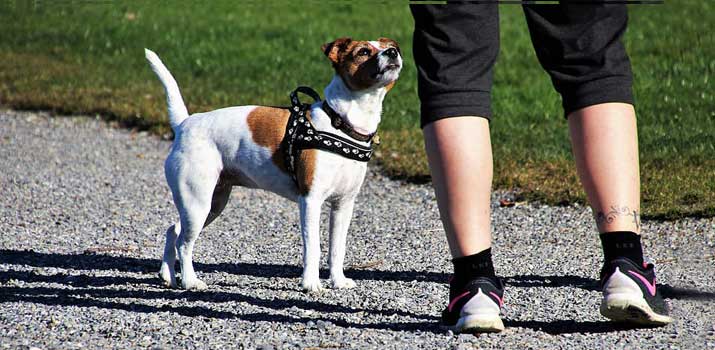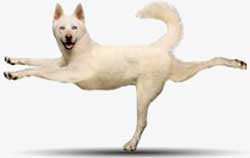Dogs can exhibit many oddball behaviors and seemingly erratic movements. They can be cool as a cucumber before snapping into the zoomies! It doesn't take much to compel dogs into acting all sorts of crazy! But at what point do strange behaviors become a point of concern?
Sideways walking, also known as crab-walking or sidewinding, is a particularly alarming behavior that puzzles many owners. As the name would imply,
it's when a canine starts to walk in a sideways orientation.

Instead of keeping a straight body that moves forwards, dogs that sidewind create a C-shape as they move.
If you see your dog walking in this fashion, it's perfectly reasonable to be a little worried. But is it a medical issue, a psychological problem, or just a strange habit?
There are many reasons for this unique walking style. Some are more nefarious than others, but it's certainly not anything you should ignore.
Here are some potential reasons why your dog is walking sideways.
9 Reasons Why Dogs Walk Sideways
#1. A Force of Habit
In some cases, crab-walking is a learned habit. You're more likely to see younger dogs exhibit this behavior after watching others do it.
For example, young pups might pick up from senior dogs or breeds that are more likely to walk that way from time to time.
Which breeds fall into that category?
Known sidewinders include Border Collies, Cocker Spaniels, German Shepherds, Boxers, Pointers, and Vizslas.
These dogs have somewhat shorter bodies than others. As a result, their front and bag legs interfere as they walk.
To avoid the coordination issues that come with that, these dogs will occasionally crab-walk short distances.
Young pups sometimes see that and develop a habit.
Fortunately, most grow out of it as they approach adulthood. If they don't, you can turn to a behavioralist and trainer for assistance.
#2. Poor Coordination in the Face of Puberty
Young pups are prone to tripping. They're little bundles of awkwardness that have a hard time staying coordinated as they walk.
Like the breeds we discussed earlier, the front and rear legs get intertwined and make walking difficult. Short bounds of sidewinding are pretty standard with growing puppies.
Even if your dog is a year or two old, they could encounter issues every once in a while.
In this case, the behavior is usually temporary.
Pups overcome the coordination issues as they reach adulthood.
#3. Dominant Leg Takeover
Did you know that dogs, like humans, can have a dominant leg?
That's not always the case. Generally, leg dominance is more evident in puppies. Amidst their awkward stumbling, you might notice a slight preference for one leg.
Most pups outgrow that domination as their bodies continue to develop. However, others will maintain it into adulthood.
When dogs have one or two stronger legs, it can pose a few harmless problems when running.
The dominant legs push off with greater force, which naturally pushes the body into a sideways orientation. Thus, the C-shaped crab-walking commences!
This type of sidewinding is typical and usually subdues with age. If not, it's pretty easy to address with training and physical exercise.
#4 Balance Issues from an Ear Infection
Ear infections are surprisingly common among dogs. Breeds with long, floppy ears are more susceptible to them. However, any dog can suffer from a bacterial or fungal infection.
The most common cause is water getting trapped in the ear canal after a bath or splash in the lake. Water can't evaporate naturally once it gets into the ear, leading to stagnation and the eventual development of fungus.
Other issues, such as mites and polyps, can lead to infection, too.
Related: Ear Mites Vs Yeast Infection in Dogs
Why do ear issues result in sidewinding? It all comes down to balance! The inner ear is responsible for giving us our sense of balance. Dogs are no different.

Deep within the ear, there are canals with fluid and extremely sensitive hairlike sensors.
Infections prevent the fluid and sensor hairs from operating efficiently, leading to all kinds of balance issues.
Sidewinding is your dog's attempt to walk normally.
Infections are pretty easy to treat, but you need to spot them before they become a massive issue. Antibiotics should take care of the problem swiftly.
Moving forward, make sure to use an ear rinse after your dog takes a bath or has some water-focused fun. That way, you can promote evaporation and prevent infections.
#5. Leg Pain
Unexpected leg pain can result in strange walking patterns.
Obvious leg issues are easy to spot. But in many cases, dogs will hide their pain from you. It's a callback to their instincts when injuries often result in death for dogs.
Your dog doesn't want to seem weak or useless, so they do their best to mask their pain.
Your dog could be suffering in silence from sprained muscles, torn ligaments, and other leg problems. When they walk sideways, they attempt to move around without applying too much pressure to the affected leg.
Seek veterinary care as soon as you can. Leg injuries can quickly snowball.
The added pressure on other legs might expose your pup to even more damages, so addressing the core problem is paramount.
#6. Hip Dysplasia
Older dogs suffer from all kinds of musculoskeletal problems. Issues like arthritis are far too common. Bigger breeds can also experience hip dysplasia.
Hip dysplasia is a condition that results in malformed joints.
More specifically, it targets the ball joint in the hip. Instead of smooth and fluid motion, the ball and socket portions of the joint grind against one another.
With time, it leads to immense pain and the eventual loss of function.
Like standard leg pain, dogs with hip dysplasia use sidewinding to get around while mitigating discomfort as much as possible.
The good news with hip dysplasia is that there are many ways to tackle the problem.
Depending on the severity of the issue, vets might recommend physical therapy, anti-inflammatory medications, or joint care supplements.
Either way, this is another condition you don't want to ignore.
#7. An Uncomfortable Harness
Irritation from harnesses and collars is more common than people realize! While these accessories are a staple for dog ownership, cheaper models can cause some severe discomfort for Fido.
Cheap harnesses are the worst offenders. Harnesses have an inherently uncomfortable design.
Straps wrap around the underside of the belly and often make contact with your pup's armpit. If the unit has inferior materials, the constant friction can lead to rash development.
The sensation is what forces dogs to walk sideways. Your pup is simply trying to find relief in an unwinnable scenario!
Do your best to avoid irritating harnesses, collars, and clothing. If you don your pup in anything that wraps around the body, inspect it closely.
Look for smooth-gliding materials that can move over the fur effortlessly.
Related: How to Measure your Dog for the Right Harness Size
#8. Intense Tail-Wagging
There's nothing cuter than watching an excited dog's tail go a mile a minute! If they happen to walk forward while wagging their tail, don't be surprised if crab-walking occurs.
These cases of excitement are innocent enough and are no cause for concern.
Your dog's excitement is causing them to wag their behinds a little too much, which throws off their balance. No worries here!
#9. A Sleeping Foot
Have you ever gotten up after sitting still for too long?
If you sat in a way that squashed the nerves in your feet, you might have to deal with a sleeping foot or that uncomfortable feeling of pins and needles.
Dogs experience that strange sensation, too. The nerves are coming back to life. The nerves start sending off extra signals thanks to the weird way your dog sat or laid down.
It's like a traffic jam in the nervous system, resulting in all kinds of strange feelings.
You're probably all too familiar with the feeling. It's like you have to take a minute for your foot to come back to life! Dogs aren't sure what's going on, so they power through.
However, the pins and needles make them prevent them from adopting a normal gait.
The sensation wears off in a few minutes, so this cause is only temporary.
Conclusion
When your dog walks sideways, pay close attention to the events surrounding it.
In most cases, crab-walking is a temporary thing that doesn't require immediate attention. But if it persists and seems to be accompanied by pain, don't hesitate to seek veterinary help.
Your dog's body and behaviors are pretty complex. While it's not possible to know what's going on all the time, you can get a good idea of what your dog's going through by paying attention.
Read their behaviors and check with your vet to rule out any serious issues.

